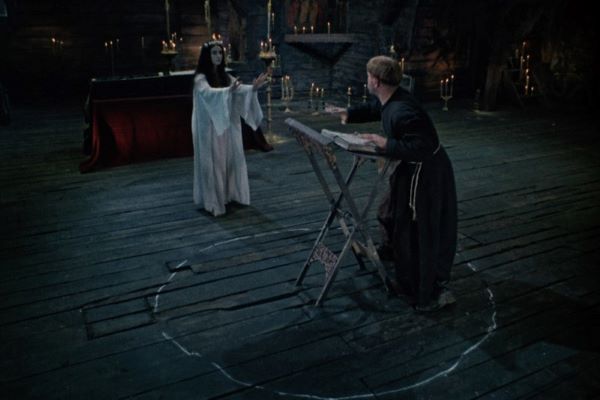One of the few horror films to emerge from the censorious Soviet Union, the makers of Viy put on a folkloric mask to get the film into production. Based on an 1835 novella by Dead Souls author Nikolai Gogol, his standing as a literary giant and his spurious claim that he had adapted a traditional tale was enough to get the Ministry of Culture to hold its collective nose. Perhaps the powers that be also liked the idea of the Russian Orthodox Church coming off worst against peasant traditions. Whatever circuitous route but happy led to its creation, Viy is a mad phantasmagoria that deserves a place in the horror canon, even if today it enchants far more than it terrifies.
A trio of young students from a seminary get lost one evening and ask for shelter at a farmhouse. The old woman who lives there attempts to seduce Khoma Brutus (Leonid Kuravlyov). When he resists she climbs on his back and begins to ride him like a horse. She then steers him into the sky, revealing her to be witch. When they land, Khoma beats her savagely. Before he escapes he sees that she has turned into a beautiful young woman (Natalya Varley). A few days later he’s summoned back to the farm where the dying daughter of a rich land owner has requested that he specifically pray for her soul. She dies before he arrives and is revealed to be the witch, but he is forced on pain of a public flogging that he must pray with the body for three nights.
Viy has been described as marrying the go-for-broke approach of The Evil Dead to subject matter more associated with Tarkovsky or Bergman. There is definitely some merit to that description. The industrial revolution seems to have skipped rural 19th-century Ukraine, where the story takes place. Indeed, it could have occurred just as easily in the 15th century of Andrei Rublev, or even the 13th century of The Virgin Spring. And the film is certainly full of the audacious, vertiginous camerawork that Sam Raimi would later utilise; a style seemingly heedless of technical limitations. But, in its full-blooded grotesquerie, the film it most closely resembles is Benjamin Christensen‘s silent classic Häxan. Viy‘s creepy, skittering ghouls and demons owe a stylistic debt to Häxan‘s irreverent and rambunctious tone, and there is a certain healthy disdain for religious orthodoxy that permeates both films.
Even at a lean 77 minutes, there are moments when Viy feels like it’s treading water. The frequent scenes of Khoma being bullied by the gargoyle-like villagers become slightly repetitious. At the same time you find yourself wishing the three nights spent with the witch and her familiars were much longer, such is the joy of their psychedelic visual mischief. The special effects themselves, by Aleksandr Ptushko (who some call the Russian Ray Harryhausen) occasionally overreach – such as in the case of the demon Viy himself – but it only adds to the heady, carnivalesque atmosphere. At a remove of over 50 years, this is rather gentle in terms of horror, but it is a strange and gorgeous tale of two superstitions butting heads to dizzying effect.
The handsome Blu-ray package also contains Djordje Kadijevic‘s Serbian gothic film A Holy Place, another take on Gogol’s source text.
Available on Blu-ray from Mon 15 Mar 2021
